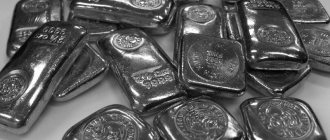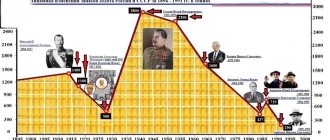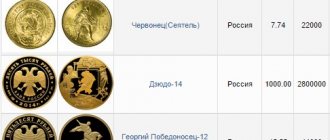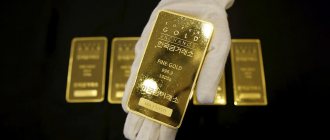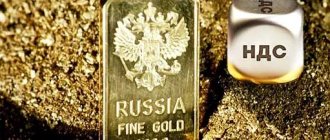Post updated: Oct 9, 2020
All gold that is mined and purchased by the state is stored primarily in the form of coins and bars, which make up the majority of Russia's gold reserves. Such a reserve is a significant component of the country’s gold and foreign exchange fund. And it is precisely this importance of the precious metal that arouses curiosity and a specific question - where is the gold necessary for the development of Russia stored?
From this it turns out that gold and foreign exchange reserves are reserve gold owned by the state, which is stored in bullion and coin form. The Central Bank of Russia has the right to use this strategic reserve.
Before the First World War, about 40% of the world's gold was in circulation, but because of the war, the economies of many countries collapsed, which is why the value of gold increased significantly after the end of hostilities. It was the war that became the impetus for the elevation of gold to the rank of an interstate strategic currency.
- History of Russian gold reserves
- Why the gold reserve is growing
- Russia's gold reserves today
- Why do countries need gold reserves?
- Where is the gold reserve stored?
The concept and objectives of the gold and foreign exchange reserves of the Russian Federation
Gold and foreign exchange reserves include highly liquid assets that are at the disposal of the Government of the Russian Federation and the Central Bank. Gold and foreign exchange reserves consist of:
- monetary gold;
- special drawing rights - SDR;
- the state's reserve position in the International Monetary Fund;
- the currency part of the National Welfare Fund - NWF;
- other assets.
Main tasks of gold and foreign exchange reserves:
- finance deficits when a balance of payments occurs;
- carry out operations on the foreign exchange market to stabilize the exchange rate of the Russian ruble;
- build trust among foreign investors and the country's population;
- maintain a stable level of the national currency - the Russian ruble;
- create a base for borrowing on international markets.
The country's large foreign exchange reserves contribute to stability, high credit ratings and lower international borrowing costs. But for the formation of reserves, funds are withdrawn from the state economy, which means that less investment flows into the real sector.
The size of the sufficiency of gold and foreign exchange reserves in the country is divided by the ratio of reserves to GDP in US dollars. In 2021, this figure reached 28%, in China - 23%, in the UK - 7%, and in the USA - 2.2%. Not every state transfers funds to gold and foreign exchange reserves, especially if it already has an established reputation and a high credit rating.
International State Reserve
At the end of 2021, the size of international reserves, according to the Central Bank of the Russian Federation, increased to $468 billion. During 2021, the figure increased by another $86 billion, and reached a size of $554 billion. By the beginning of 2021, the gold and foreign exchange reserves reached the level of $595.7 billion .
Gold and foreign exchange reserves are growing primarily due to diversification and purchases of physical gold. In 2021, Russia purchased more than 275 tons of the precious metal, and in 2021 and 2021, the trend continued, 158 and 27 tons were purchased, respectively. But the positive growth trend was halted due to the COVID-19 pandemic, stalling growth at just below 3,000 tons.
Russian news feeds have repeatedly been full of headlines that the country's gold and foreign exchange reserves have exceeded the amount of external debt. In fact, it is important to consider that the amount of debt to foreign countries is a composite value. It includes not only Russia’s current debt to other countries, but also current debts of corporate business. And when calculating the gold and foreign exchange reserves, only government assets are taken into account. Therefore, the values are poorly comparable with each other.
Foreign exchange reserves in the Central Bank of the Russian Federation are formed in US dollars, euros, Swiss francs and Japanese yen. According to the structure of Russia's gold and foreign exchange reserves, about 75% is accounted for by foreign currency. The share of gold in the Russian Federation is incomparably lower than that of European countries, where the average is 50-55%.
Banks whose shares are owned by the state (not a controlling stake)
The state owns shares in banks not only directly, but also through organizations and holdings controlled by it. That is, the constituent documents indicate the data of the enterprise, but it does not belong to a private business, but is a state-owned company.
EXAMPLE:
| Gazprombank is only 9% directly owned by the state - securities were purchased through Vnesheconombank. The majority of the shares are owned by Gazprom and its subsidiaries, which in turn are completely under the control of the Russian Federation through the Federal Property Management Agency, Rosneftegaz and Rosgazifikatsiya. Therefore, a nominally private bank is actually a state bank. |
Banks that are indirectly controlled by the state include a fairly significant part of companies. Among the most famous:
- SME Bank (more than 71% of the shares are held by the Federal Property Management Agency, the rest by VEB);
- RRDB (Rosneft holding owns 84% of the bank's securities);
- RGS Bank (96% owned by Otkritie State Bank);
- Credit Ural Bank (100% of shares from Gazprombank);
- BM-Bank (fully controlled by VTB);
- Cetelem Bank (79% of assets are held by Sberbank).
A controlling stake in stock exchange terminology is 50% of shares + 1. There are banks on the Russian financial market where the participation of certain government agencies in the capital of a private company is below this value. Thus, the Republic of Tatarstan owns about 8% of the shares of Akibank, Rostec holds 16% of the securities of Zarechye Bank on its balance sheet, Ekaterinburg Bank is 29% owned by the administration of the city of the same name, and Kazan Bank is 39%.
Russia surpasses Saudi Arabia in gold and foreign currency reserves
Russia currently ranks 4th in international reserves, pushing aside Saudi Arabia, which dropped to 17th position by the end of 2021. This situation arose due to the increased influence of the Russian Federation in negotiations with the OPEC alliance, when discussing issues regarding the volume of oil production. Despite the fact that barrel prices dropped significantly in 2021 and 2021, the Government of the Russian Federation managed to fulfill all social obligations without attracting funds from gold and foreign reserves.
Current oil prices turned out to be much lower than expected in OPEC countries, including Saudi Arabia. In the Saudi capital, Riyadh, with a lack of revenue from oil sales, they are forced to spend gold and foreign exchange reserves on social needs. While in Russia a regime of increased reserves has been introduced for several years due to fear of further sanctions from America and the Eurozone countries.
Saudi Arabia, with the price of Brent oil below $55-60, is not receiving the budgeted profit, so the country's reserves are being used up. Ongoing trade wars coupled with the pandemic are leading to even lower prices in the oil market.
In Russia, there is a fairly widespread opinion in business circles that it is necessary to transfer less to the country’s gold and foreign exchange reserves and spend more to develop its own economy. But at the moment, the state adheres to the chosen path and follows the approved strategy.
Dynamics of Russia's gold reserves over a century (1913 - 2020)
Russian gold - foreign exchange reserve from 1913 to 2021 changed as follows:
- In pre-revolutionary Russia in 1913, the value of the gold metal reserve was 1,338 thousand tons. Until the end of the summer of next year, a gold standard operated in Russia, that is, a monetary system in which gold was the reference unit for any calculations. Each ruble monetary unit corresponded to 0.78 grams of gold.
- At the initial stages of the 1st World War in Russia, gold and foreign exchange reserves had the following structure: 1,695,000,000 rubles or 1,311 tons of gold and more than sixty billion dollars. Russian reserves were significantly reduced after being sent to England. The rest of the reserves were in Petrograd, later they were mostly transported to Nizhny Novgorod and Kazan, and before the revolution - to Finland.
- In 1918, after the signing of the Brest-Litovsk Treaty in the USSR, 250 tons of valuable metal were moved to Germany.
- In 1920, the value of Russia's gold and foreign exchange reserves decreased by almost twelve tons of gold (15 million Russian rubles) due to shipment to Estonia; four million in gold - due to payment to Latvia; by five million - due to payments to Turkey; by 200 tons of gold - due to the acquisition of English and Swedish locomotives.
- Reserves reached their historical peak under Stalin. In 1941, they increased to 2,800 tons of gold; after 12 years, the reserves amounted to 2,500 tons.
- Further dynamics look like this: 1993 - 4; 2000 - 12; 2005 - 124; 2007 - 303; 2008 - 478; 2014 - 496.7; in 2021 - 377: as of March 1, 2018 - 453,644 billion American dollars (USA).
Abandonment of US bonds in favor of gold
The improvement of the Russian Federation's position was influenced by the policy of the Bank of Russia. He continues to actively divest from US government bonds while simultaneously increasing purchases of physical gold. This strategy was chosen in response to the imposed anti-Russian sanctions.
In the spring of 2021, the Russian Federation reduced the volume of investments in American securities by $1.6 billion. Investments fell to a minimum of $12 billion. This was reported by the US Treasury Department.
The maximum investment in American bonds was reached in 2010 - $176.3 billion. In November 2014, the volume decreased to 108 billion, and by December there were only 86 billion dollars. The sharpest reduction in investment occurred in the spring of 2021; Russia got rid of American securities worth $47.5 billion. The Russian Federation's portfolio in the United States was reduced by almost half.
In 2021, the Russian Federation invested small amounts in US bonds, but the final volume did not exceed 2% of the country’s gold and foreign reserves. In April 2021, investment fell below $4 billion.
The head of the Central Bank of the Russian Federation explained that such diversification of reserves is caused by financial, economic and geopolitical risks. It is not safe to invest in the economy of a country that imposes anti-Russian sanctions.
Where is the fund stored in Russia?
If we talk about where the gold reserves of Russia are located, then the reserve is located in the vault of the Central Bank of the country, but not in its entirety, but 2/3 of the total volume of the fund. The repository is located in the capital of the state. It is administered by the Central Bank of the Russian Federation.
Part of Russia's gold fund is also located in the vault of the Central Bank, located in the following cities:
- Saint Petersburg;
- Ekaterinburg.
A certain amount of Russian gold bars is stored in the United States of America in the Fort Knox fortress. In this case, the US Government is responsible for the safety of the reserve. There are also gold bars of the country itself and a number of other powers in case of an unforeseen situation.
Why gold and not the dollar
Historically, the states of the world created their reserves in gold. But in 1944, at the Bretton Woods conference, the United States promoted its national currency. The American currency began to act as an obligation to convert the dollar and gold.
Over time, the “Gold Standard” moved away and was replaced by free conversion. The dollar has become a world currency on a par with a precious metal. In 1971, with the fall of the Bretton Woods system, the United States abandoned the proportional conversion of its national currency into gold. But the dollar still maintains a dominant position in the international reserves of different countries.
The advent of the euro changed the situation a little. A number of leading European countries sought to prevent the excessive strengthening of the dollar, but now the confrontation has become conditional.
Since 2010, the world's central banks have stopped selling gold and have become exclusively buyers. Some countries, of course, continue to sell their reserves, but most often this happens to cover external debt. 2021 saw very high demand for the precious metal. Most countries in the world leave their gold reserves intact. This is the most sought after reserve during periods of economic downturn or geopolitical instability. The same situation was observed in 2020. However, in the Russian Federation, the growth rate of gold purchases was not as significant as in the previous 2 years.
Over the past 6 years, gold has tripled in the structure of reserves. The data in the table is given at the beginning of the year:
| Year | Size of gold and foreign exchange reserves, billion dollars | Ratio of gold and currency in billions of dollars |
| 2015 | 385 | 46 and 339 |
| 2016 | 368 | 48 and 319 |
| 2017 | 377 | 60 and 317 |
| 2018 | 432 | 76 and 356 |
| 2019 | 468 | 86 and 382 |
| 2020 | 554 | 110 and 444 |
| 2021 | 595 | 138 and 457 |
The strategy chosen in Russia today is aimed at increasing the volume of gold reserves in the structure of the country’s reserves. China is following the same course, reducing investment in US securities and increasing physical gold reserves.
Current performance and latest data
In December 2021, Russia ranked 5th in the world among countries in terms of declared gold reserves, China was in 6th place. If we take into account the IMF's gold and foreign exchange reserves, the position of Russia and China becomes 6 and 7, respectively.
Russia informed the world community about its ownership of 2298.5 tons of gold at the end of 2021. The share of monetary gold is $133.67 billion, which in the total value of gold and foreign exchange reserves reaches 22.9%.
Read about the dollar exchange rate forecast and how to invest in gold in Brobank's articles.
Sources:
1. International reserves of the Russian Federation weekly. 2. International reserves of the Russian Federation monthly values
about the author
Klavdiya Treskova - higher education with qualification “Economist”, with specializations “Economics and Management” and “Computer Technologies” at PSU. She worked in a bank in positions from operator to acting. Head of the Department for servicing private and corporate clients. Every year she successfully passed certifications, education and training in banking services. Total work experience in the bank is more than 15 years. [email protected]
Is this article useful? Not really
Help us find out how much this article helped you. If something is missing or the information is not accurate, please report it below in the comments or write to us by email
Degree of fund protection
The fund contains gold bars with special markings. The weight of one product is 10-14 kg. The bars are placed in steel boxes that can provide protection for the precious metal in case of fire in the storage facility and various damages that may occur as a result of an emergency.
The storage itself is also securely protected. The country's gold reserves are protected by special services. Modern alarm systems are installed inside the storage facility. Thanks to this, as a result of unauthorized entry into the premises, not only the special services, but also the Government of the Russian Federation will immediately become aware of it.
Everything about Russia's gold reserves on video.
Comments: 2
Your comment (question) If you have questions about this article, you can tell us. Our team consists of only experienced experts and specialists with specialized education. We will try to help you in this topic:
Author of the article: Klavdiya Treskova
Consultant, author Popovich Anna
Financial author Olga Pikhotskaya
- elektrik
04/14/2020 at 11:00 So how much gold is there in tons (grams)?The question remained unanswered!
Reply ↓
Klavdiya Treskova
04/14/2020 at 11:19 Post authorThank you for your attention, the article has been updated to reflect your question.
Reply ↓
